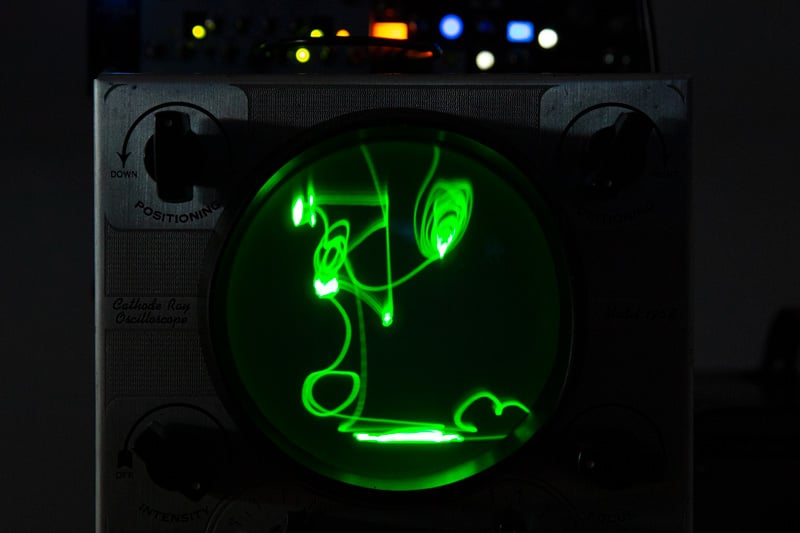Hello, dear fellow synthesists and music technology aficionados. If you have been to our showroom within the last several months, you’ve probably taken notice of its ever-changing nature. This particularly applies to a room formerly occupied by three enormous guitar pedal boards—since their dismantling, it has been in a state of non-stop transformation. As modular synthesizer fans, we appreciate dynamics and change, and we thought that this could be something that we could integrate further into our operations. We decided to start our experiments with the space within our showroom.
The core concept is simple: to create a space that is easily transformable at a moment's notice, and to integrate it into the life of LA synth and music tech community. For the last few months, we have already enacted a few iterations of the idea, though we are only scratching the surface of what it can be. So with this article, let us together explore what it is now, what it can be, and how you can participate.
Events, Workshops, and Classes
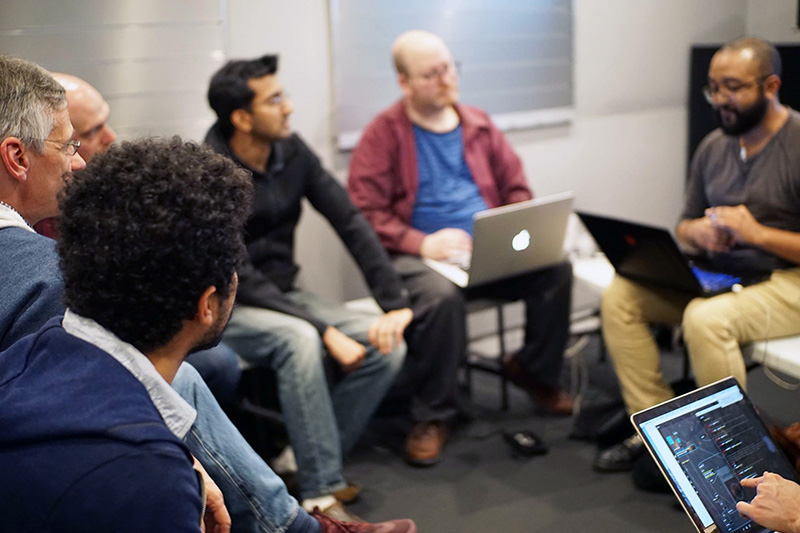
Since the inception of the idea of adapting the space, education immediately surfaced as something that we would want to dedicate our energy towards. We strongly believe that knowledge is one of the ultimate values that one can share with others, and we want our space to be a platform for that. Events and workshops have already become some of the most dynamic aspects of the space, and we hope it will continue to grow. Yes, we still are doing big in-store manufacturer-centric events, but this room is reserved for more content-focused, educational, and community-driven events.
We now host a regular meetup event dedicated to the Max/MSP development platform called Meet and maX. The gathering happens the last Saturday of each month from 3PM to 6PM. If you consider yourself a Max user, have projects you’d like to share, or are simply curious and want to know more about the software or its integration with hardware—feel free to join the next meetup event.
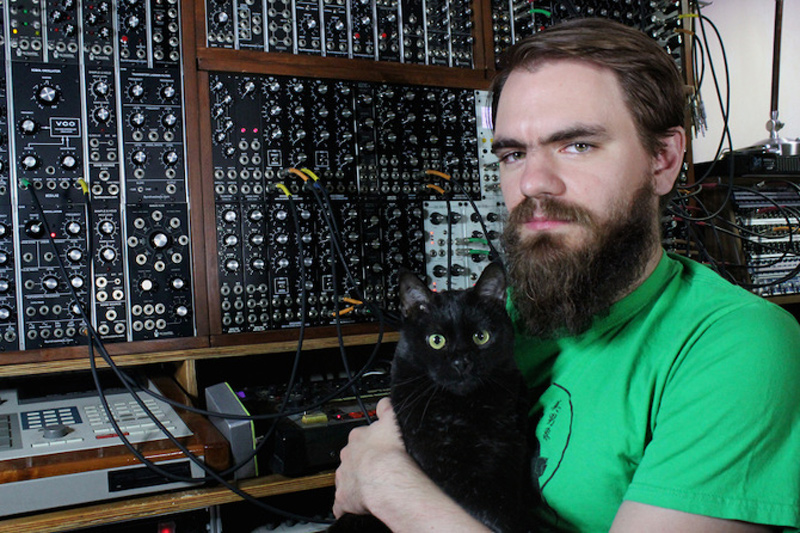
A particularly interesting workshop is coming up on the first day of the next month (June 1st). Film Scoring Using Modular Synthesizers and Max/MSP led by Jonathan Snipes (clipping.) is a clinic designed to explore the various applications of software and hardware modular environments as they relate to composing music for films. At the moment it looks as if all the available spots for that workshop are filled, so if you really would like to come we advise that you keep checking our Events page in case someone decides to cancel. In any case, worry not—as we are planning on having more educational workshops in the future, including introductory and more advanced synthesis-focused seminars, as well as communal study sessions of particular pieces of gear.
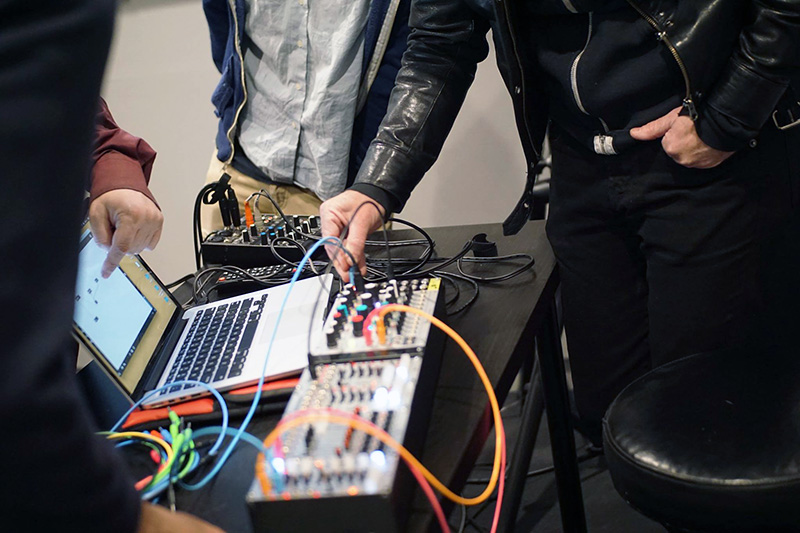
Always feel free to drop us a line if there is something in particular that you are interested in learning. In case we get enough inquiries about a certain subject, we will definitely put our efforts towards making a workshop happen. And of course, we are open to partnerships and collaborations. If you have ideas you can fill in this form, and we will reach back based on our bandwidth at the given time: Partnership & Collaboration Inquiry Form
If you want to learn about synthesis, recording, or other music technology things but prefer one-on-one style tutoring—this is also possible. Follow this link and let us know the details of your learning objectives, and we will reach back to you with options: 1-on-1 Class Inquiry Form
Interactive Sound Laboratory
Events, classes, and workshops are all awesome, but you may be wondering what we do with that space on a daily basis. Day to day, the space functions something like an interactive Sound Laboratory, where we showcase ready-to-play, curated setups, systems, and other novel and functional gear combinations suited for experimentation.
Let’s face it, our personal home setups rarely look anything like the isolated machines in our showroom. While this is a great way to familiarize yourself with some particular unit, often a context of how machines interconnect in meaningful ways is valuable. Furthermore, depending on the peculiarities of the genre and sound one is after, the setups vary drastically. We wanted to create an environment within our shop where experimenting with full setups would be easy to achieve. Our first round of dedicated setups is up and running, so let us take a tour through each station individually.
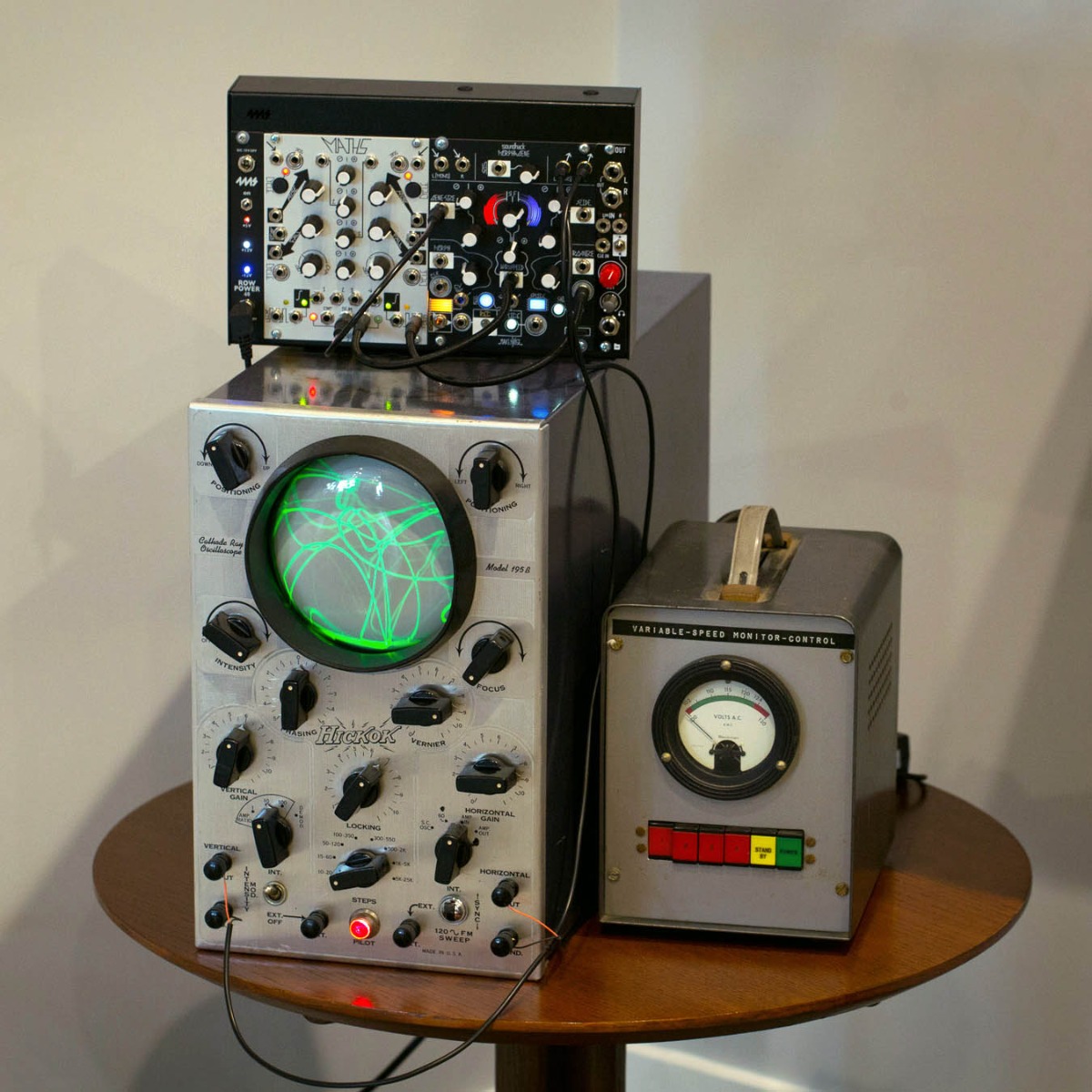
Vector Synthesis
As you enter the space, a vintage oscilloscope dynamically painting green images immediately captures your attention. The test apparatus is fed an audio signal from a small Eurorack system encapsulated in a compact 4MS pod. The centerpiece of that system is Make Noise Morphagene with a special Vector Synthesis Reel on its microSD card, originally prepared as a collaboration between Make Noise and BR-Laser. Maths provides a sufficient amount of modulation options, while Befaco’s Output module allows for listening to our patch as we observe the shapes morphing in the 2-dimensional space of the oscilloscope’s screen.

MIDI Polyphonic Expression
MPE is perhaps one of the more exciting things that happened to the world of music technology in the last few years. Although it facilitates an impressive amount of potential for expressivity while performing with electronic instruments, to this day the feature is not very widespread; in fact, there are only a handful of hardware synthesizers that speak the language of MPE. One such instrument is Black Corporation’s Deckard's Dream—a modern MPE-enabled synth that is heavily inspired by Yamaha’s classic CS-80. Our choice of a perfect companion-controller for the machine fell on the immensely flexibleLinnstrument, designed by the pioneer electronic instrument builder Roger Linn.
The power-couple is augmented via a chain of curated effect-pedals that includes the Retro Mechanical Labs Electron Fuzz Custom Distortion to add extra warmth and grit, Empress Effects Echosystem for all kinds of delay processing, and Chase Bliss Dark World to soak all the sound layers in the ether of otherworldly reverb.

Drone 'n’ Noise
For those among our customers who share our deep passion for discord and chaos in music, we have constructed this setup. It starts with a 12-oscillator-based JMT NOSC-12 drone synthesizer designed to grace your ears with a swarm of soundwaves beating against each other. Retro Mechanical Labs's pedals have always been known to work exceptionally well with synthesizers, so we’ve added the RML Hyde Distortion to crumple and warp the sound of oscillators further. Next is the JMT SRV-1: a spring reverb that adds some spice to the overall sonic mayhem. Finally, we’ve augmented the setup with the one oscillator to rule them all: Trogotronic's TR-Valkyrie. At its minimum, this configuration of devices can provide you with interplaying drone textures for days—but with a twist of a few knobs, total sonic annihilation is unavoidable.
String Machine
Don’t listen to your friends who say that guitars are not cool anymore—they totally are! In fact, with this many sound mangling options, there never was a better time for transforming the sound of the instrument as now. I may go as far as saying that guitars can easily be treated like synthesizers with strings.

That is what this setup is all about—taking in the raw electric guitar sound and transforming it beyond recognition. As such, we’ve chosen some of the most powerful pedals to accommodate that task. At the input stage, the signal is amplified via the SansAmp GT2 amp modeling pedal. Next, it enters the high-gain realm of Gamechanger Audio’s unmistakable Plasma pedal. Further, the sound dives into the strange world of Industrialectric RM-1N reverb distortion.
And then comes the Empress Effects ZOIA, a full-fledged modular effects framework. One might think that there is nowhere to go beyond this point, but we’ve placed Hologram Devices Infinite Jets, and the living-classic Strymon BigSky to provide you with more options to blur and wash the sound before it reaches Old Blood Noise’s convenient Headphone Amp pedal.
Less is More
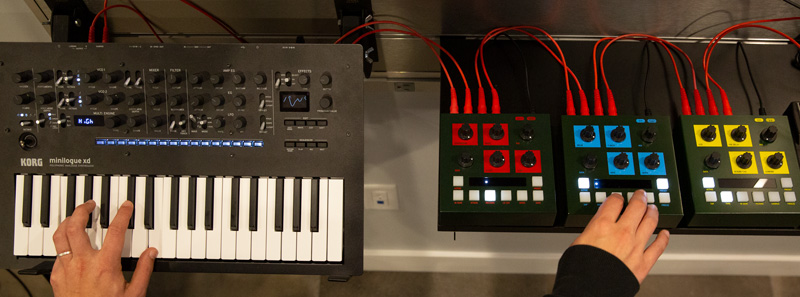
Big setups are appealing, but sometimes we forget that putting just a couple of powerful items together not only suffices our musical needs but also provides a necessary limitation to boost creativity. I can’t express enough how often I found myself getting to the “Aha” moments while working around intentionally stripped-down setups.
Here we have a single synthesizer as the main sound source. We’ve chosen Korg Minilogue XD for its particularly balanced combination of features and compact size. The output of the synthesizer is then routed into a trio of high-quality stereo effect processors from the French manufacturer OTO Machines. BOUM acts as a compressor/overdrive/distortion unit able to either slightly warm up or completely twist the incoming signal (with all the options in between). BIM is a 12-bit stereo delay processor configurable to all-sorts of time-based effects. The chain is closed with a BAM—perhaps one of the most-loved and sought-after stereo reverb units on the market today.

ONE +
When Moog Music announced the release of their polyphonic mega-synthesizer Moog One, our showroom staff was bombarded with questions regarding its availability, and its ETA to our store. Given the history of the company, the quality of their products, the uniqueness of the synthesizer itself, and let's be honest, the seemingly (though reasonably) high price point of the ONE—the overwhelming interest in the device is entirely understandable.
When we thought about the possible gear candidates to put in the space, it was a no-brainer to us that this synthesizer deserved a special spot...and it got it. Moog One takes a central position in our Sound Laboratory space with its output connected to speakers, ready at any point to fill the room with the beautiful tones it produces. Dim the light if necessary, immerse yourself in the atmosphere, and become one with the Moog One (pardon the pun). Additionally, the sound of the synthesizer is connected to the audio input of the Critter and Guitari’s video synthesizer ETC, so feel free to also experiment with the audio-reactive element of this setup.

Practical Magic
For this section of the room, you don’t even need to touch anything to make a sound: simple handwaving and dancing will do just fine. We’ve recently racked up three perfectly functional vintage D-Beam controllers (yes, these are pre-Roland devices). We were so excited about them personally, that we couldn’t resist the urge of letting our local synth community get a share of the fun. All three units control the parameters of yet another Eurorack micro-setup via the powerful Bastl Instruments 1983 MIDI-to-CV module. The combination of Mutable Instruments Marbles, Make Noise QPAS, Strymon Magneto, Befaco Dual Attenuverter, and Make Noise Rosie modules are carefully patched to quickly respond to movements in front of the IR sensors installed in the D-Beams. Just come, vogue in front of the setup, and listen to the resulting sounds!

Electro-Acoustic Studio
We are now at our last stop (for now), but even here it is possible to get sucked into the world of sonic experimentation for quite a while. This is perhaps the most modular of all the presently available setups in the space, and it couldn’t be different given that its purpose is to be open and re-patchable. As the field of electro-acoustic music suggests, a composer-musician utilizes both elements of acoustic sounds, as well as sounds derived from electronic devices to achieve unique and organic auditory experiences.
Koma Elektronik’s Field Kit and Field Kit FX were designed exactly for that. These devices let you amplify acoustic sounds, process them through onboard effects, and integrate DC-motors, solenoids, and various sensors to generate and control sonic and control voltage events. You’ll find contact microphones, a magnetic pickup, motors, marbles, and springs spread around the work surface ready to serve the experimenter’s purpose. The setup also features several other effects processors to provide more flavor. These include Eventide H9, Strymon Timeline, and the quirky Landscape Stereo Field. Two volumes of 50 Ways To Use Field Kit and Field Kit FX should provide you with plenty of ideas and inspirations to get things going.
As mentioned earlier in the article, the fundamental principle that we assign to the Sound Laboratory space is flux. This means that space will often take on a new look and be filled with new setups. If any of the music stations described in this article appeal to you, you should come by and play with them sooner rather than later. Something new is already cooking!
On a final note, we would like to stress once more that if you are in Los Angeles area and would like to get involved in one way or the other with our space and local music tech and synth community, there are a couple of ways to do this. We are doubling the above mentioned forms below for convenience:
Partnership & Collaboration Inquiry Form: Have an idea for a workshop you'd want to lead? Have an event or installation that would work well at our space? Let us know!
1-on-1 Class Inquiry Form: Looking to learn more about the world of synthesis and sound production? Let us know what you would want to learn!

